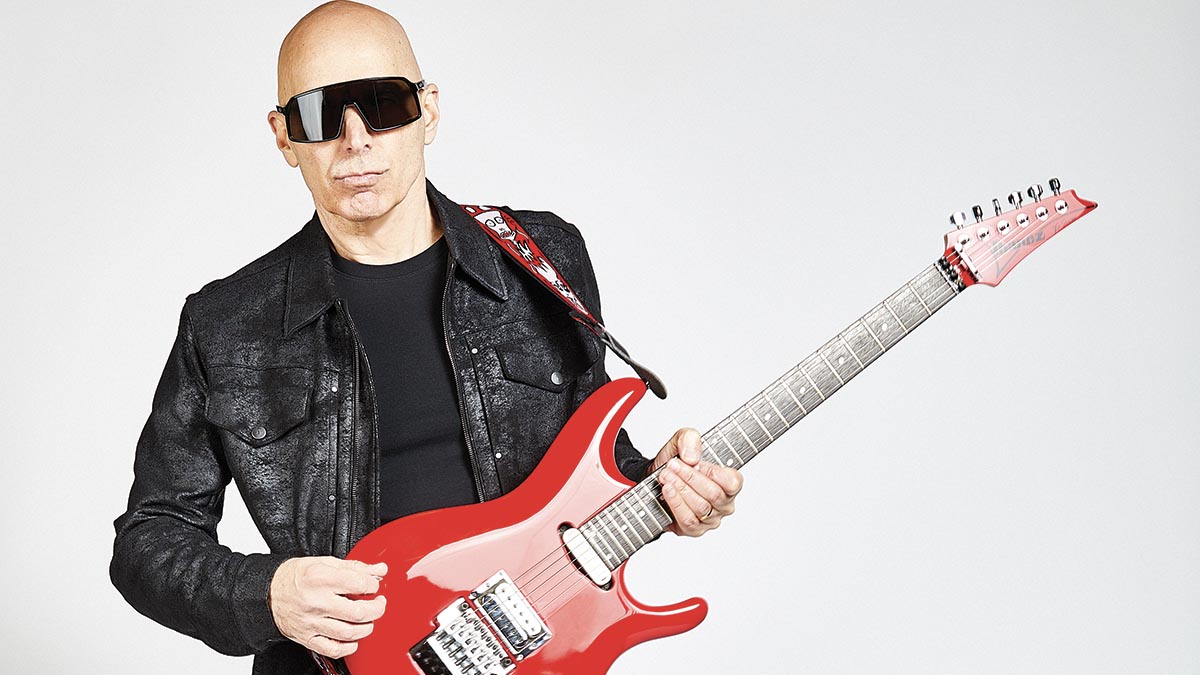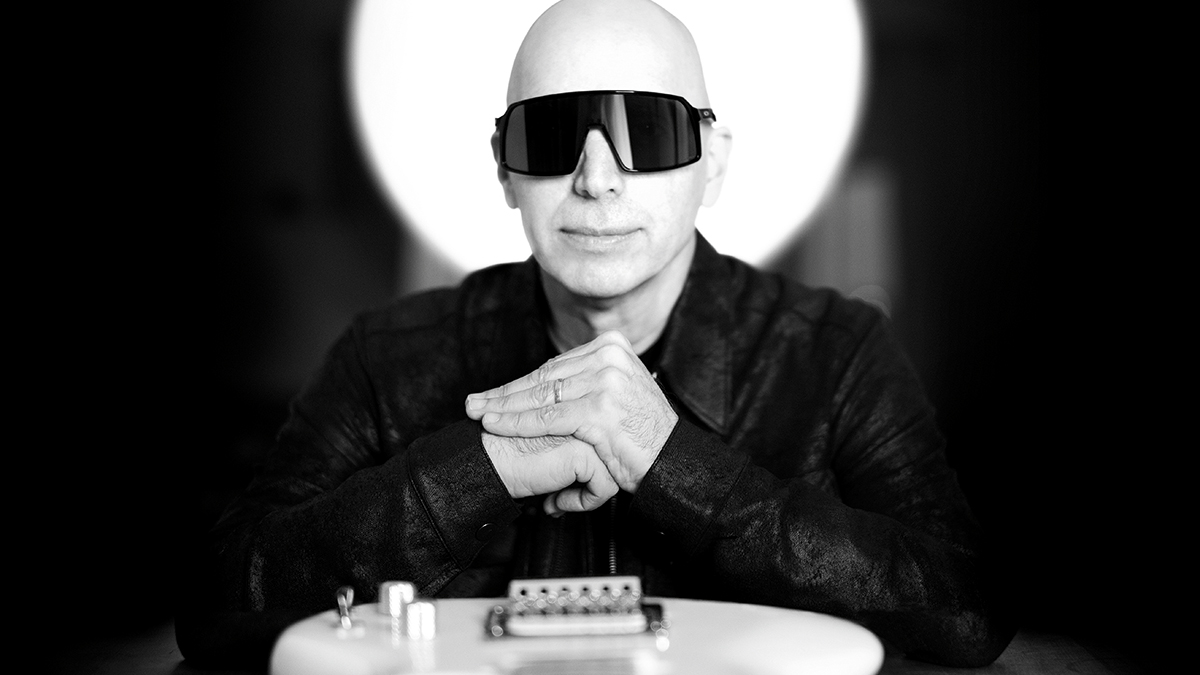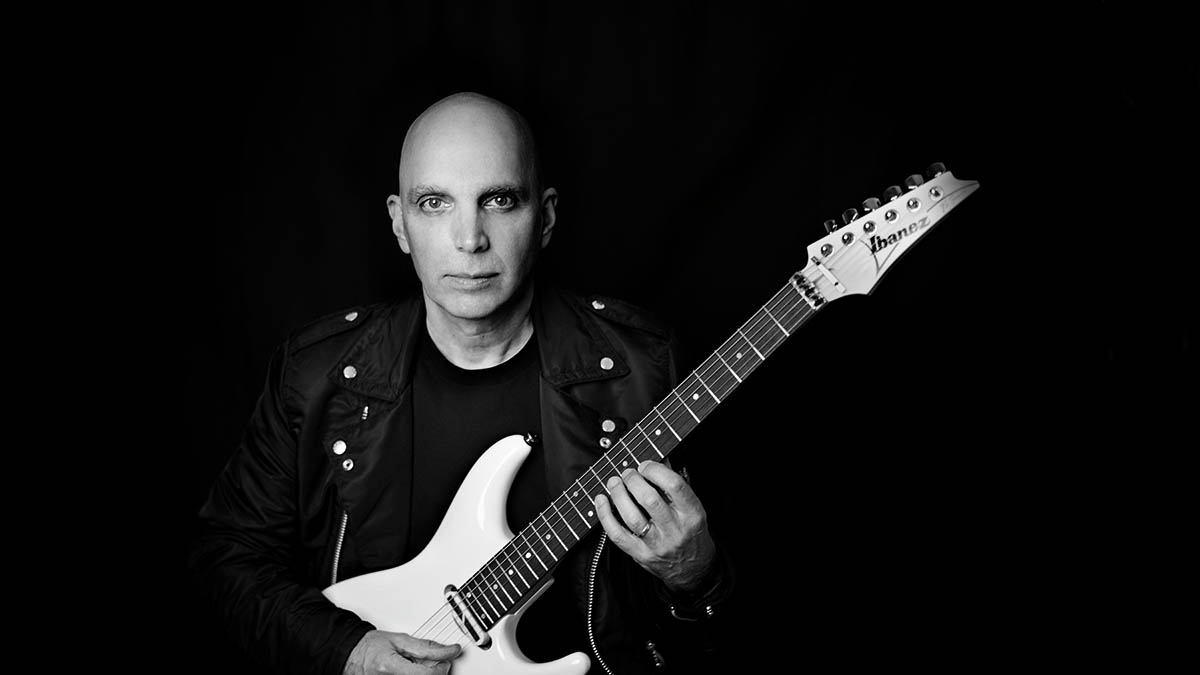Joe Satriani: “There's got to be 100 guitar players out there who I love watching every day because they do things I could never do”
How Satch's search for a “new standard” for instrumental guitar albums resulted in The Elephants of Mars, an album recorded without creative barriers – or physical amplifiers

It must be difficult to watch an album you labored over for months get released into a world on lockdown. But in April 2020, Joe Satriani made the decision to put out his 18th solo album, Shapeshifting, a month into the Covid pandemic in hopes the world would be back to business as usual in a matter of months, and he could play it live for fans around the world on tour.
As those optimistic early days of the pandemic passed, Satch settled into longer-range plans. Excited by the band he had assembled – Kenny Aronoff on drums, Bryan Beller on bass and newcomer Rai Thistlethwayte on keys – he decided to record some new songs to supplement Shapeshifting before they hit the road. But, alas, plans shifted again, and instead he conceived an entirely new album, The Elephants of Mars.
“I was really energized to come up with a new angle, so I spent a lot of time talking with Eric [Caudieux, producer and longtime collaborator] about how we could break down some of the barriers that were always up,” Satriani says. “Let’s say you walk into the studio and you go, ‘I want to make a blues record,’ or whatever it might be.
“When you make up your mind about that, you eliminate possibilities and pathways for expression because you’ve got to focus. So coming up with these concepts about what we were going to allow ourselves to do really opened up this wonderful sort of tidal wave of creativity between us.”
The Elephants of Mars opens with a backward-guitar intro that leads into Sahara, built on a relentless rhythm with a series of hypnotic half-bends played on an Ibanez AR3212 12-string electric to mount the tension. During the song’s percussive breakdown, Satriani rips a David Gilmour-inspired solo, then steps on a Dunlop JHW2 Jimi Hendrix Signature ’69 Psych Octavio Fuzz pedal to push his fretwork into hyperdrive.
The cinematic musical landscapes Satriani creates throughout the album turn on a dime, like how the pulsing main riff of Sailing the Seas of Ganymede segues into noise-guitar breaks.
The wild, industrial title track is a dark ride through a Gotham-esque nightscape that opens into dreamy interlude and culminates in a psychedelic guitar freakout. And the acoustic-based, Eastern-leaning Doors of Perception gives the album another of its many unpredictable moments, played on his signature Ibanez JSA20 and an electric sitar.
Get The Pick Newsletter
All the latest guitar news, interviews, lessons, reviews, deals and more, direct to your inbox!
But The Elephants of Mars also stands apart in his four-decade career as the first album recorded at his home – or, several homes, technically. Satriani collaborated with Caudieux and his band by tracking on his Ibanez JS guitars and sending the audio files back and forth without ever being in the same room with his producer or the other musicians. The songs ended up changing directions multiple times based on the artists’ spontaneity.

“There wasn’t a time clock,” he says. “We weren’t showing up at a studio for 10 days to get all the basics and then three weeks to finish all the overdubs. That’s the way I’ve made albums for decades and that’s really stressful, and when you’ve got 45 minutes to do a banjo part, you’ve got 45 minutes, and that’s it.”
The Elephants of Mars proves that Satriani’s recent non-musical forays, such as his Crystal Planet comic book series, a collaboration with Ned Evett, also serve Satch the guitarist, recharging his creative well and expanding his adventurous musical palette. Satriani called Guitar World to talk about creating his new album amid unprecedented times.
The Elephants of Mars saga began with your plan to make two records: an instrumental album and one with vocals. What made you change course?
“The timing of everything. In January 2020, I had a new album ready to come out [Shapeshifting]. I had just done a video for the song Nineteen Eighty. I was doing some press down in L.A., the NAMM Show, that kind of stuff. I think the last thing I did on stage was join Steve [Vai] at one of his NAMM performances. Then I got back to San Francisco and everything shut down.
“And I started thinking, if there’s going to be this big lag, six months before we show up on stage with this new album, maybe we could take advantage of that off time to create some music that would showcase the band. And then as we finally do get back on the road, maybe we give these away, like free albums that are supplementary to Shapeshifting.
“It all seemed like a fun idea. The newest member in this circle was Australian Rai Thistlethwayte, who’s an amazing musician – a keyboard player, guitar player, singer – and I really wanted to give him some room to do what he can do as a frontman and a singer. We decided, ’Well, let’s do a sprawling instrumental record where everybody gets to solo like crazy, and then a sprawling vocal record where we’ll just have fun with our roots.’
“Because we weren’t aiming for hit singles or something like that; we were actually just introducing ourselves as a new band to the audience. That dragged on, unfortunately, so all of a sudden it’s like, 'Oh, all right. We’ll do it in ’21.' And then that started to look really bad. I realized so much time, emotionally, has gone by for the public that people are going to expect just a new album.
“They’re not thinking of a supplemental series of releases to support a record that was [released] at the beginning of the pandemic. We had to rethink the whole idea. I called the guys and I said, 'Look, change of plans. We’ll forget about the vocal record, and I’m going to start working on the concept of a new instrumental release.'
Some of the absolute, most amazing guitar players have risen to the occasion and have figured out how to wow you in those few moments just playing in front of a camera
You were interested in creating a new standard in instrumental guitar music. What was your vision?
“There are people writing and playing and practicing and performing in front of a phone for a 15-second moment of wow. That’s not Jimi Hendrix or Miles Davis. I don’t know what that is, to a certain extent.
“On the negative side, it’s just some kind of weird form of musical cotton candy, but on the positive side, some of the absolute, most amazing guitar players have risen to the occasion and have figured out how to wow you in those few moments just playing in front of a camera.
“I mean, even the sound is completely discounted now, like, who cares if you’re hearing the electric guitar acoustically as well as hearing it in whatever amp or modeling thing is happening in the background? Nobody cares.

“However, I have to say I love it, and there’s got to be 100 guitar players out there [who] I love watching every day because they do things I could never do. I just think it’s amazing that they’ve done it, and that they’re actually moving the art of guitar forward, but in a very strange way compared to what was around five years ago.
“And in the same way, I think that TV and MTV, as you go backwards in the decades, you see how each new leap forward in technological media has changed the way musicians get ahead in life. That had a lot to do with my thought process. I thought, I just want to remove certain things that some people may think is a requirement for an instrumental album, and I want to focus on things I think are really interesting to explore.
“It’s not just about, 'Look, I figured out how I can play higher up the neck.' That’s really not what interests me, anyway. But there is a whole group of players out there who’ve taken that challenge upon themselves and they’re excelling to fantastic heights. So I wanted to bring something else that I thought was missing, which is to deliver something deeper. That’s what a person in my position should be doing.”
Were there specific creative elements you singled out to pursue in doing that?
“This album was different because I was doing all the guitar at home. It was a different kind of a record to put together logistically, and that really helped because there was no rush. We would send stuff to each other via email and we’d get stuff back without speaking to each other and we’d sit there and just listen to it, and it wouldn’t be any on-the-spot judgment that was necessary.
“There were great accidents that happened along the way. And I have to say everybody maintained this level of spontaneity that you’d think would never happen if there was all this time and everybody was by themselves. But in fact, everyone kind of got the idea that they needed to record really spontaneous, interesting performances. And it was not about charting everything out the way that the arrangers or the artist demanded.”

I was going to ask how you broke out of your conventional methods of working, but it sounds like the entire thing was unconventional.
“Yeah. It’s interesting that, let’s say if we go back to Shapeshifting, that was pretty conventional. In fact, it was kind of retro for me because we had 10 days for basics and two or three weeks for overdubs, and we recorded in a warehouse, Jim Scott’s studio. I think that showing up with 100 guitars and 20 amps, that kind of thing, I’ve done that so many times.
“In this case, though, I started to think, I don’t know when we’re going to get in the studio to finish this album, so I’ll do what I’ve done for the last 15, 20 years, which is make sure I also record everything direct so that we can re-amp it later. This time around, I did what I’ve been doing with demos.
“I just took my guitar, whatever was the one that was my favorite [at the moment], and I went into my Millennia Media HV-37 mic pre and went right into Pro Tools and I just recorded DI, so everything was DI and I would monitor using AmpliTube or whatever was fun at the moment, because I kept thinking this is going to be re-amped at some point. Little did I know that it wasn’t. Somewhere along the line I realized I’m not going to get into a studio. This record is going to be done all at home. Everybody’s home.
“And so I started that process of re-amping at home, and the strangest thing happened, which was I kept going back to SansAmp. What I noticed was that the plugin had a way of allowing me to be really dynamic in this particular situation where you’re in a studio by yourself and you’re playing to tracks people have been sending you. I just found it so uniquely pliable and it was very attentive to every little thing I was doing.
“I thought, okay, this is kind of interesting. I don’t know how it’ll pan out, but I’m not going to plant the flag about using this until we get Kenny on the drums, because it’s all about the drums. You don’t really know the size of your recording until you get your drum performance down and the bass is added.
“In the end, the SansAmp just seemed to work with these tracks, and probably it’s because I was listening to it as I was performing, and I was reacting to it. So that magic, that synergy, got on tape.”
You didn’t use physical guitar amps on the record at all?
“None. But we really do have to discuss what Greg Koller did during the mixing. Greg was our main mix and mastering engineer, and he and Eric mixed the record. I was unable to attend any of the sessions, so I was just getting them every night and we would play around with different ideas. But Greg was working out of Jon Brion’s studio.
“Jon was very gracious in letting us use the studio for mixing, and in Jon’s studio is some of the greatest outboard gear from the last 80 years of recording. I was told that a lot of my guitar, if not all of it, would eventually make its way through Les Paul’s own personal [Universal Audio limiter] 1176 and lots of other gear that Jon had acquired through different estate auctions.
“He really was able to take what was down there on the hard drives via SansAmp and he was able to just really maximize his potential through his own wizardry.”
Had you done virtual or modeled amps to that extent before on a record?
“Yes and no. Going back to 1999, Eric and I did a record in his living room, Engines of Creation. We didn’t use speakers, but we had about 10 amplifier heads and a Palmer speaker simulator. And there were a couple of things we did where there was a SansAmp – I think that was the only plugin at the time that was worth using – and we would combine it.
“When I was working with Andy Johns on The Extremist and then on Chickenfoot’s first album, it was so traditional. It was stacks of amps and you turn them on 10 and you leave the room and you record layers, and you always combine Les Paul and Telecaster with your Ibanez and you always put a 12-string here and Nashville tuning there.
“So when I would get a chance to not do that, I would go, ‘Yeah, I’m excited. Let’s not do that.’ I think that’s the most shocking thing when I just sat here and I was writing up the equipment list and I thought, oh my God, there’s one entry: SansAmp.”
Were there any new ways that you approached writing your guitar parts?
“If I’m in a particular kind of mood, I just reach into the musical toolbox and say, ‘Well, this is what’s going to make this mood happen. It’s going to make it real. It’s going to make it palpable for the listener eventually.’ And I never really know what it’s going to be.
“I mean so much of the music was very reactionary to a mood. And although some of it was written and performed really fast, other stuff took months of reflection before that aha moment would arrive and then all of a sudden you’d record something in three minutes.
When you remove the lyrics, you’re left with just the repetition of the notes, and so it doesn’t really work. You can’t just do an instrumental version. You have to rewrite it
“Take the song Sahara. That was a vocal song I wrote for Rai, lyrics and everything, and then it just didn’t happen. It wound up on the Do Not Do pile, and then months later it was suggested by Eric that perhaps I revisit it and see if there’s a way to make it an instrumental. And it’s very different [now].
“Instrumentals have their own requirements for melodic development. When you remove the lyrics, you’re left with just the repetition of the notes, and so it doesn’t really work. You can’t just do an instrumental version. You have to rewrite it.”
The title track has a lot of opposing moods. What was the thought behind that song and how the parts developed?
“Some of the songs have this history that’s crazy. [The Elephants of Mars] got its start as I was taking breaks from different albums over the last seven, eight years, and I would write musical cues for what we would hope would be the Crystal Planet animated TV series.
“I just started creating these short versions of ideas and I’d send them to Ned. There was one that I just kept falling in love with, and it was a very retro-Nine Inch Nails kind of thing, but it had this clean guitar solo to it.
You spend three days working on something where it’s got like six electric guitars and then one day you go, 'I’ve got to pick up an acoustic because I just don’t want to hear high-gain guitar anymore'
“And the funny thing was that it had this weird, elephant sort of robotic, monster sound. As I would listen to these things over and over, I would start to think more cinematically and story-wise, as Ned and I were always developing different stories. The idea about these elephants being real started to be something I wanted to somehow figure out.
“This piece of music winds up with Eric, and he took this second part where there’s this really clean guitar solo, and he just got rid of all the music underneath the guitar solo and he rewrote all the chords, and he went to halftime, the total breakdown section.
“Once I heard what he had done with the breakdown, I was really inspired to create more of a rock ’n’ roll guitar freakout, but still keeping in mind the ‘elephants from Mars’ kind of thing. The whole thing crystallized pretty quickly once that final guitar solo was put on there.”
Cinematic is probably a word that gets overused, but it makes sense here considering that you were doing all those cues and thinking more in a visual sense.
“It’s interesting how some of these pieces got their start a really long time ago, and then, there are pieces like Doors of Perception that were written very close to finishing the album. And perhaps you spend three days working on something where it’s got like six electric guitars and then one day you go, ‘I’ve got to pick up an acoustic because I just don’t want to hear high-gain guitar anymore.’
“Here’s a funny story about how weird things get. So, Sailing the Seas of Ganymede, I had this piece for a couple of years and I was dying to get it on the last two albums. For some reason it never fit. And then this time around, it would seem perfect.
“And I added a couple of things to it and I sent it off to Rai and I was determined to get him soloing on as many songs as I could. And he sent it back, but he put his [keyboard] solo in the wrong place. But as soon as we heard it, we were like, ‘Well, that’s the new right place.’ It didn’t make any sense that somebody would solo there, but that’s because I’d heard the song for too many years. Sometimes you just need somebody in the band to just do something that they’re not supposed to do and it just kind of wakes you up.”
- The Elephants of Mars is out now via earMusic.
Jim Beaugez has written about music for Rolling Stone, Smithsonian, Guitar World, Guitar Player and many other publications. He created My Life in Five Riffs, a multimedia documentary series for Guitar Player that traces contemporary artists back to their sources of inspiration, and previously spent a decade in the musical instruments industry.
“The Beyoncé effect is, in fact, real. I got a lot of traffic just from people checking the liner notes”: With three Grammy wins and plaudits from John Mayer, Justus West is one of modern session guitar’s MVPs – but it hasn’t been an easy ride
“You might laugh a little. The post office shipped your guitar to Jim Root”: This metal fan ordered a new guitar from Sweetwater – but it ended up with the Slipknot guitarist




![John Mayer and Bob Weir [left] of Dead & Company photographed against a grey background. Mayer wears a blue overshirt and has his signature Silver Sky on his shoulder. Weir wears grey and a bolo tie.](https://cdn.mos.cms.futurecdn.net/C6niSAybzVCHoYcpJ8ZZgE.jpg)

![A black-and-white action shot of Sergeant Thunderhoof perform live: [from left] Mark Sayer, Dan Flitcroft, Jim Camp and Josh Gallop](https://cdn.mos.cms.futurecdn.net/am3UhJbsxAE239XRRZ8zC8.jpg)




